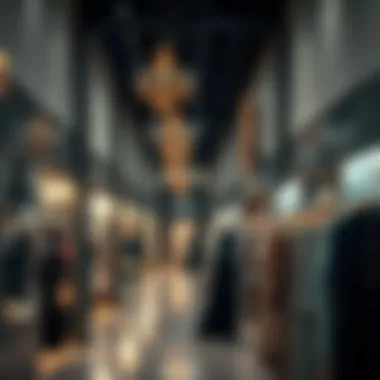Explore the Diverse Abaya Shops in Dubai


Intro
In the sprawling metropolis of Dubai, where tradition intertwines with modernity, the abaya stands as a sartorial symbol of heritage and elegance. The abaya is not merely a garment; it is a representation of culture, identity, and individual style. As visitors flock to the city, whether for business or leisure, many find themselves on a quest to explore the abaya shopping scene. This pursuit is not just about purchasing a piece of clothing; it is a deep dive into a world rich with storytelling, craftsmanship, and evolving fashion trends.
Spanning from opulent boutiques to vibrant markets, the choices are as diverse as the individuals who wear them. Each store offers a glimpse into the artistry and creativity involved in abaya design. Understanding the nuances of this shopping experience—such as current market trends, styles available, and cultural significance—becomes essential for anyone wishing to navigate what can feel like a labyrinth of options.
As we venture into the depths of this comprehensive guide, we will uncover the vibrant tapestry of abaya shops in Dubai. Expect to explore current trends that influence the market, the key shopping locations, and various styles that cater to all tastes. This exploration is directed toward not just fashion enthusiasts but also investors and stakeholders who recognize the evolving consumer landscape surrounding this traditional garment.
Stay tuned as we embark on this educational journey through the intricate fabric that makes up the abaya market in Dubai.
Preamble to Abayas
The abaya is more than just a garment; it embodies the rich cultural heritage and traditions of the Middle East. This traditional attire serves as a symbol of modesty and identity, particularly among women in the Gulf region. Understanding the significance of the abaya in Dubai is essential for anyone considering the purchase or appreciation of this attire. With Dubai being a melting pot of cultures, abayas here reflect a diverse range of styles and personalization that transcends geographical limitations.
Historical Context of the Abaya
The origins of the abaya can be traced back centuries, evolving from functional clothing to a symbol of elegance and status. Traditionally, it provided coverage and comfort, allowing women to move freely in society. The garment has been adapted over time, influenced by both local traditions and global fashion trends. Initially, abayas were simple, often made of dark fabrics. As trade routes expanded, so did the variety of materials and designs available. Today, the abaya is not only a reflection of heritage but also a canvas for contemporary artistry and fashion innovation.
Cultural Significance in Modern Society
In modern society, the abaya holds a dual significance. For many women, it's a personal choice representing their cultural identity and values. However, it also serves as a statement piece in the fashion world. Major fashion houses and local designers alike create stunning collections, blending traditional motifs with modern aesthetics. The changing landscape of style has also prompted discussions around women's rights and self-expression, making the abaya a focal point in contemporary socio-political dialogues. It becomes a powerful symbol of choice—a way for women to express their individuality within communal norms.
Evolution of Styles Over the Years
Over the years, the abaya has transformed dramatically in terms of style and presentation. Early designs were predominantly black and straightforward, but as fashion evolved, so did the colors and embellishments. Nowadays, one can find abayas adorned with intricate embroidery, beads, and even digital prints. The introduction of breathable fabrics also allows for comfort in the hot desert climate, combining practicality with style.
"The evolution of the abaya mirrors the changing roles of women in society, showcasing both tradition and modernity crucial for the contemporary woman."
From dramatic cuts to minimalistic designs, the variations in abaya styles cater to diverse tastes and preferences. Thus, potential buyers are often met with a spectrum of options, reflecting not only individual style but also the varied cultural influences that characterize Dubai.
In summary, an appreciation for the abaya's historical roots, cultural importance, and transformations over time provides a deeper understanding and context for shoppers in Dubai's vibrant abaya market.
The Abaya Market in Dubai
The abaya market in Dubai holds a crucial place within the broader context of fashion and cultural identity. This segment of the retail scene is not just about clothes; it encompasses a rich tradition, diverse styles, and innovative designs that reflect the intersection of heritage and modernity. With numerous shops, unique brands, and a vibrant shopping experience, Dubai stands out as a global hub for abaya fashion.
Overview of Dubai's Retail Landscape
Dubai's retail landscape is a melting pot of high-end luxury and traditional market stalls. The emirate is renowned for its expansive shopping malls, such as the Dubai Mall and Mall of the Emirates, which feature international brands alongside local boutiques. This fusion creates an unmatched experience for shoppers, where one can browse through both trendy international styles and unique, locally-crafted designs. The accessibility of various abaya shops is one of the primary reasons Dubai attracts shoppers from all over the world.
Types of Abaya Shops
High-End Boutiques
High-end boutiques in Dubai are synonymous with luxury and exclusivity. These establishments focus on unique abaya designs that often incorporate high-quality fabrics, intricate embellishments, and innovative silhouettes. Visiting a high-end boutique offers a more personalized shopping experience, with many boutiques providing tailored services to create a custom look. Such shops often carry famous designers and their collections. The key characteristic that sets these boutiques apart is the meticulous attention to craftsmanship, which can greatly enhance the status of the owner. However, prices can be steep, with some pieces reaching upwards of several thousand dirhams, making this option more suitable for those with a generous budget.


Local Markets
Local markets, such as those found in the Old Dubai district, present a diverse range of abaya styles that appeal to budget-conscious shoppers. Here, one can find traditional designs alongside contemporary variations, often at much more affordable prices. The charm of local markets lies in their vibrant atmosphere and the opportunity for haggling, which creates a sense of adventure in shopping. A notable feature is the cultural engagement; here, potential buyers can immerse themselves in the local way of life. However, keep in mind that there could be a variance in quality and selection compared to high-end boutiques.
E-commerce Platforms
In recent years, e-commerce has significantly influenced the way consumers shop for abayas in Dubai. With platforms like Namshi and Ounass, shoppers can browse a vast array of styles and brands from the comfort of their homes. This convenience allows for easy comparison of prices and styles, making it a popular choice for those who may not have the time to visit physical stores. Additionally, many e-commerce websites offer easy return policies and special discounts, increasing their appeal. However, the downside may stem from not being able to physically try on garments, which can lead to sizing issues.
Key Players in the Market
When it comes to abayas, a few key players dominate the Dubai scene, consisting of both established brands and emerging designers.
Established Brands
Established brands like AlAneeq and Taya offer a mix of classic and contemporary abayas. These companies have carved out a niche in the market with their reliable quality and stylish designs. They typically reflect traditional aesthetics with a modern twist, appealing to both local residents and tourists. The advantage of shopping from established brands is the assurance of quality and the reputation behind the designs. However, prices can reflect that reputation, sometimes making them less accessible to all consumers.
Emerging Designers
Emerging designers like Dhabia and Aseel bring fresh ideas to the abaya market, often experimenting with fabrics, patterns, and cuts. Their innovative approach can set trends and cater to a younger demographic seeking unique and bold statements. Supporting these designers not only champions creativity but also nurtures local talent. The downside may be that, due to limited experience, some new designers might still be developing consistency in quality and sizing.
Custom and Tailored Options
Custom and tailored abayas allow shoppers to embrace their individuality. Many shops offer a bespoke service, ensuring that the garment fits perfectly and aligns with the wearer’s personal style. This service often includes a range of fabric choices, colors, and design elements, enabling clients to create a piece that is entirely unique. While this can lead to significant customer satisfaction, the process may take longer compared to simply purchasing an off-the-rack item.
"In a land where tradition meets modern ambition, the abaya market offers a reflection of identity and innovation."
The vibrant abaya market in Dubai offers something for everyone, whether you’re looking for high-end luxury, a charming experience in a bustling local market, or the convenience of online shopping. Understanding the different shopping experiences can enhance your journey into the world of abayas, making it richer and more rewarding.
Shopping Experience
The shopping experience when it comes to abayas in Dubai is not just about purchasing an item of clothing; it embodies a rich tapestry interwoven with cultural significance, personal expression, and a unique interaction with fashion in a bustling city. This experience stands apart due to the sheer variety and quality on offer, along with the dynamic atmosphere of the retail environment. Abaya shopping is often more than a chore; it's an exploration of tradition and modernity, allowing individuals to connect with their heritage while making a fashion statement.
Navigating the Stores
Entering an abaya store in Dubai can feel like stepping into a realm of creativity and artistry. The layout of these stores is generally designed to guide visitors smoothly through displays that range from classic to contemporary designs. Most shops will have a plethora of abayas on hangers, showcasing the intricate details like embroidery, beading, and cuts.
As you navigate the aisles, it becomes easier to identify what resonates with your personal style. Familiarizing yourself with the store’s layout can save time, especially if you have something specific in mind. Often, certain sections will cater to different styles—from the elegant simplicity of a traditional black abaya to the vibrant colors and patterns of modern adaptations.
"A good shopping venture requires a curious mind and an open heart."
Additionally, store staff are usually well-versed in abaya styles and can offer helpful guidance. Engaging them not only simplifies choices but also sparks discussions about fabric types or seasonal trends, enriching your overall shopping experience.
Personalization and Customization Options
One of the most captivating elements of abaya shopping in Dubai is the opportunity for personalization. Many shops, whether high-end boutiques or local markets, provide customization services. Customers can request specific fabric types, colors, or embellishments tailored to their personal preferences.


This option not only ensures a unique garment, but it also ignites a creative collaboration between the buyer and the designer. Some stores will even offer fittings, where customers can try on their chosen styles, making adjustments right there in the moment. This level of tailored service turns the shopping experience into a memorable adventure, and it's an excellent way for buyers to express their individuality through fashion.
Pricing and Budget Considerations
When it comes to abayas, understanding the price range can help strike a balance between quality and budget. The cost of abayas in Dubai varies widely, influenced by factors like the store type and the complexity of design. High-end boutiques like Al Nakhuda and Pashmina might offer high-quality materials and intricate craftsmanship that come with a steeper price tag. In contrast, local markets such as the Bur Dubai Souk can provide more budget-friendly options.
It’s essential to set a budget before embarking on your shopping journey. Here's a quick overview:
- High-End Boutiques: Expect prices to range from AED 600 to AED 4,000, depending on design and fabric.
- Local Markets: You can find options starting as low as AED 100.
- Customization Services: These can add about 20-30% to your overall cost but often deliver exceptional value due to personalized touches.
Visiting multiple stores can provide a broader understanding of what's available at different price points, helping you find something that speaks to you while keeping your budget in check.
Popular Abaya Styles and Trends
The abaya is not just clothing; it’s a canvas that reflects the rich tapestry of culture, personal style, and innovation in fashion. Understanding popular abaya styles and trends is vital for anyone looking to navigate the world of abayas in Dubai. With a blend of tradition and modernity, these garments tell a story and offer endless opportunities for personal expression.
Traditional vs. Modern Designs
The dichotomy between traditional and modern designs is a defining feature of the abaya landscape. Traditional abayas are often characterized by their simplicity and elegance, featuring classic cuts and solid, muted colors. They are typically made of lightweight fabrics, allowing for comfort in Dubai's warm climate. Embroidery, often crafted with intricate patterns, is a common embellishment, adding a touch of sophistication.
In contrast, modern designs have taken the abaya to new heights, incorporating a variety of fabrics, colors, and styles that cater to contemporary tastes. Designers experiment with asymmetrical cuts, layering, and eye-catching prints, transforming the abaya into a statement piece that resonates with younger generations. For instance, you might find an abaya adorned with bold graphics or one that features a fashion-forward silhouette, appealing to those who desire both style and functionality.
Seasonal Trends and Collections
Much like any other segment of the fashion world, abaya styles shift with the seasons. Each collection brings forth fresh designs that reflect seasonal palettes and motifs. For example, during the summer months, lighter fabrics and pastel shades are favored to complement the vibrant environment of Dubai.
On the other hand, autumn and winter collections often introduce deeper hues and heavier fabrics, making use of velvet or wool blends. Print variations also emerge during these times, with floral patterns or geometric designs catering to festive occasions and celebrations. Keeping an eye on these seasonal trends not only enhances your wardrobe but also ensures you’re in tune with the latest styles.
"Fashion is an expression of who you are and may evolve with culture and time."
Influence of Fashion Weeks and Exhibitions
Fashion weeks, exhibitions, and trade shows in Dubai play a crucial role in shaping abaya trends. Events like the Arab Fashion Week showcase a multitude of designers, providing a platform for innovation and creativity. Designers often debut their latest abaya collections, drawing attention from both local and international buyers. This, in turn, influences consumer preferences and sets the tone for what’s in vogue.
Moreover, exhibitions focused on modest fashion give designers the opportunity to network, allowing them to gain inspiration from varied cultural perspectives. They also provide insights into the growing importance of sustainability and ethical fashion practices, something increasingly significant to consumers today. As an investor or a fashion enthusiast, staying informed about these events can provide valuable insights into market trends and future investment opportunities.
Sustainability in Abaya Fashion
In today's fashion landscape, sustainability has become more than just a trend; it’s a necessity that resonates with consumers, especially within the realm of traditional garments like abayas. The growing awareness around environmental issues is prompting shoppers to seek out options that reflect their values, driving the demand for sustainable fashion solutions.
By focusing on eco-friendly materials and ethical production practices, the abaya market is evolving to embrace a more responsible approach to fashion. This shift not only addresses the environmental impact of clothing production but also enhances the cultural significance of the abaya itself as a timeless garment redefined for contemporary society.
Understanding sustainability in abaya fashion isn't merely an academic exercise—it's essential for discerning customers who want their choices to positively impact the world. As consumers grow treasure-hunt style for sustainable options, abaya retailers are stepping up to meet this challenge, thus transforming the shopping experience into a more conscientious one.
A commitment to sustainability in fashion benefits not just the planet but also the consumers, as it encourages them to wear garments that hold meaning beyond aesthetics.


Eco-Friendly Materials
When we delve into the specifics of eco-friendly materials utilized in abaya production, it becomes clear there's a wealth of options available. Many designers are steering clear of synthetic fabrics that often require heavy chemical processing and look towards biodegradable alternatives. Organic cotton, bamboo, and linen have emerged as more sustainable choices.
- Organic Cotton: Unlike conventional cotton, organic cotton is grown without the use of synthetic pesticides or fertilizers, making it a healthier choice for both the environment and the consumer.
- Bamboo: This fast-growing plant requires minimal water and no pesticides. Bamboo fabric is also naturally antibacterial, which adds to its allure.
- Linen: Made from the flax plant, linen uses a fraction of the water that cotton does, making it a smart choice for those concerned with resource conservation.
Additionally, some high-end designers are experimenting with sustainable fibers derived from recycled plastics or other recovered materials. This innovation not only mitigates waste but also gives new life to materials that would have otherwise ended up in landfills.
Ethical Production Practices
Beyond the materials, the ethics behind how abayas are produced is an equally vital aspect of sustainability. Many consumers today are advocating for higher standards in labor practices, which means a growing number of brands are adopting more transparent and responsible manufacturing processes.
- Fair Labor Standards: Ethically produced abayas are often made in facilities that prioritize fair wages, safe working conditions, and reasonable working hours for employees.
- Local Production: Supporting local artisans and manufacturers not only reduces carbon footprints associated with transportation but also fosters community relationships and preserves traditional craftsmanship.
- Transparency: Brands providing clarity about their supply chain and production methods help consumers make informed choices. More and more abaya shops are adopting this transparency, sharing their practices openly with shoppers.
In summary, sustainability in abaya fashion is an essential pillar for contemporary consumers. By prioritizing eco-friendly materials and ethical production practices, the fashion industry, particularly within the vibrant abaya market of Dubai, is aligning itself with a more mindful future.
Care and Maintenance of Abayas
Taking care of an abaya is not just about preserving a garment; it's about maintaining a piece of cultural heritage that reflects style and personal expression. Proper care ensures that the fabric remains pristine, colors stay vibrant, and the fit remains as perfect as the day it was bought. In Dubai, where the climate plays a significant role in fashion, understanding the nuances of abaya maintenance becomes crucial.
Regular maintenance not only extends the lifespan of an abaya but also preserves its quality. When buyers invest in an abaya, whether it's made from silk, cotton, or more modern materials, they should be aware of the care procedures to avoid any damage. The physical appearance of an abaya often is a reflection of its owner; thus, taking pride in its upkeep speaks volumes.
Washing and Handling Instructions
Washing an abaya can seem daunting, especially if it features delicate embellishments. However, knowing the right washing techniques can save it from premature wear.
- Check the Label: First and foremost, always read the care label for specific guidance. Different fabrics might have unique requirements, and following these instructions can help maintain the integrity of the material.
- Gentle Wash: Abayas are best washed on a gentle cycle if using a machine. Ideally, hand washing with cold water and mild detergent will be even gentler. Be cautious of using harsh chemicals that can fade or damage the fabric.
- Avoid Wrinkling: When rinsing, consider using a fabric softener to help ease wrinkles. If possible, iron on a low setting or steam the garment instead of direct contact with an iron.
- Drying Techniques: For drying, it's recommended to air dry your abaya instead of using a dryer. Hanging it to dry in a shaded area where direct sunlight cannot reach will prevent color fading and maintain its shape.
- Spot Cleaning: For small stains, dab the area with a clean cloth soaked in water and mild detergent, rather than soaking the entire garment. This helps maintain the fabric's overall quality and appearance.
"Proper care not only enhances longevity but also keeps your abaya looking as stunning as the first time you wore it."
Storage Tips for Longevity
Storing an abaya properly is just as important as how you wash it. Improper storage can lead to creases, fading, or even fabric damage.
- Choose the Right Hanger: Use padded hangers to prevent stretching and maintain the shape of the abaya. This helps in keeping the sleeves and silhouette intact.
- Cover Up: Ideally, use breathable garment bags made from cotton – this allows air to circulate.
- Avoid Sunlight and Humidity: Store abayas away from direct sunlight to prevent color fading. High humidity can encourage mold growth, so a cool and dry place is best.
- Organize by Use: If you have multiple abayas, it might be wise to organize them by how often they're worn. Keep your seasonal or frequently-used abayas at the top for easy access.
- Check Regularly: Make it a habit to inspect your abayas occasionally. Look for signs of wear, and address any issues early before they become chronic.
By understanding the care and maintenance of abayas, wearers can ensure that their garments remain as beautiful as they are functional, reflecting their unique style for years to come. This knowledge not only empowers them but also respects the cultural significance inherent in abayas.
Ending
The world of abaya shopping in Dubai is both intricate and enchanting. Understanding this dynamic landscape is crucial for anyone looking to explore or invest in this distinctive cultural apparel. The conclusion of this article encapsulates the essence of the previous discussions, emphasizing the richness of the abaya as not just a garment but a living symbol of tradition interwoven with modernity.
Recap of Key Insights
During our exploration, several pivotal points emerged:
- Cultural Impact: The abaya, deeply rooted in historical contexts, reflects not only the identity of its wearers but also the broader social changes regarding women’s fashion in the Arab world.
- Diverse Market: The availability of various abaya styles, ranging from traditional to contemporary, showcases the adaptability of this attire in Dubai’s bustling retail scenery.
- Shopping Experience: Customers seeking an abaya in Dubai can expect personalization options that cater to individual tastes, fostering a unique shopping experience.
- Sustainability: With growing awareness of environmental issues, the emphasis on ethically sourced materials within the abaya fashion community is undeniably significant.
These insights underscore the abaya’s relevance in styles and its profound cultural importance.
Final Thoughts on Abaya Shopping in Dubai
The next time you approach an abaya shop in Dubai, remember that each piece is more than just fabric; it carries with it stories and meanings, waiting to be explored and appreciated. Equipping oneself with knowledge and sensitivity transforms the shopping experience from a transactional to a truly enriching journey.



